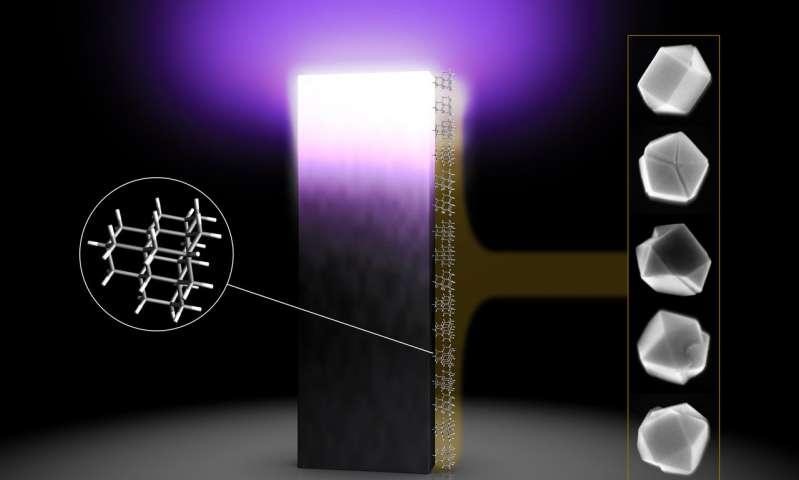
The figure shows a large piece of diamond crystal (left) grown by diamond nanoparticles (right). Several trillions of diamond particles are attached to the surface of a silicon wafer and then placed in a carbon, hydrogen plasma (purple), which is the two elements necessary to form diamond. A new study found that diamonds only begin to grow when the system contains at least 26 carbon atoms. Image source: SLAC National Accelerator Laboratory
Natural diamonds are formed by the combination of tremendous pressure and temperature from deep underground. But synthetic diamonds can grow through nucleation and grow a large piece of diamond crystal from a tiny "seed." Just like the tiny particles in the clouds will slowly gather and grow up, and finally melt into raindrops and spill the earth.
Recently, scientists have observed the growth of diamond at the atomic level for the first time, and obtained the critical size value of the rapid growth of diamond "seed".
The results of this week's study published in the Proceedings of the National Academy of Sciences show that the nucleation process of atoms not only occurs in diamonds, but also in various atmospheres, in the silicon crystals of computer chips, and even in proteins in the nervous system. will happen.
"Atomic nucleation is a fundamental principle in materials science, and almost every textbook has relevant theories and formulas to describe it in detail," said Professor Nicholas Melosh from the SLAC National Accelerator Laboratory at Stanford University. "For example, from liquid water to solid ice, it is the way we describe from one phase to another."
But interestingly, he said, "Although this theory has been unanimously recognized by material scientists, it has never been verified by experiments. Because of the limitations of the instrument, it is very difficult to observe the growth process of crystals at the atomic level. of."
In fact, scientists have long known that classical nucleation theory often overestimates the energy barrier required for nucleation. Therefore, they found a way to combine theory with experiment, but until now, researchers can only observe it on a larger scale, and it is still very important to study the nucleation process on the atomic scale. Difficulty.
To study the nucleation mechanism of diamond atoms at a minimum scale, Melosh and his team focused on the smallest atom of diamond.
The latest round of experimental research was led by Stanford University postdoctoral researcher Matthew Gebbie. He has been deeply researching the interface, the so-called phase interface, that is, the boundary between one substance and another, such as the boundary between air and water. CVD (Chemical Vapor Deposition) is widely used in the production of industrial and jewel-like diamonds, and it has been proven that the phase interface is critical for the process of chemical vapor deposition to produce diamond.
In order to prepare large diamond crystals by chemical vapor deposition in the laboratory, the team scattered numerous tiny diamond particles on the surface of the silicon wafer and placed them in a plasma of hydrogen and carbon (they formed diamonds). The two elements necessary), the plasma at high temperatures will cause electrons to peel off from the atoms.
Gebbie said that this plasma can dissolve diamond particles and also promote the nucleation of diamond particles. The competition between the two determines whether it can form a larger diamond crystal structure. There are many ways to incorporate carbon atoms into solids, but only under the most suitable conditions will we get sparkling diamonds, otherwise you will end up with only some extremely cheap graphite, which we usually see. Pencil core only.
The study gave scientists a finer control over the nucleation process of diamonds. Because they are so tiny, even though we can't see them directly with the most advanced electron microscope, we can sort them precisely according to the number of carbon atoms contained, and then attach them to silicon by chemical vapor deposition. The surface of the wafer is placed in a plasma atmosphere.
Although there has been a lot of research on diamond nucleation, this is the first test done with diamond particles of different sizes. The team found that diamond crystal growth is only promoted when it contains more than 26 carbon atoms.
More importantly, Gebbie said that they were able to directly measure the energy barrier of diamond particle nucleation growth, which is undoubtedly a landmark discovery.
Gebbie added, “This is a very basic study, but what is most exciting for us is that we have found a predictable and very reliable way to make diamond nanomaterials. Now we have got the foundation we need. The theory, the next thing to do is to find ways to put these diamond nanomaterials into practical use."
SZM7045 Zoom Stereo Microscope
Szm7045 Zoom Stereo Microscope ,Stereoscopic Zoom Microscope,Stereo Zoom Binocular Microscope,Zoom Stereoscope
Ningbo Beilun Kalinu Optoelectronic Technology Co.,Ltd , https://www.kalinueot.com
